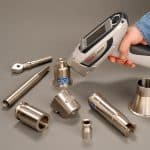Positive Material Identification has become a convenient and reliable way to determine the alloy compositions of materials. One of the greatest advantages of using a PMI unit is its portability, weighing approximately 5-8 lbs. with the battery loaded into the unit, it can be easily transported and used in confined areas or field applications.
With the use of x-ray fluorescence, these handheld units use low radioactive x-ray tubes to expose the elements in the material being tested. The reflected radiation generates energy. Each element has its own atomic structure; the reflection will generate a different energy level for every element. This energy is measured and detected, which then identifies the alloy elements. This allows the user to identify materials that have a missing pedigree (mill certification), or to compare the actual material composition to the certification provided by the producer.
Modern X – Ray Fluorescence (XRF) analyzers are one of the fastest and most comprehensive methods for Positive Material Identification where low level radiation is directed at the material that is being verified. The energy levels reflected back from each element is measured, thus identifying the alloy elements. XRF works, by exposing the material to a flux of x-rays. The atoms then absorb the energy and become temporarily excited causing them to fluoresce, or emit x-rays. The x-rays emitted by the materials atoms possess clearly defined energies that are unique to the elements present in the sample. By measuring the intensity and energy, the XRF instrument can provide qualitative and quantitative analysis. In other words, it can identify the elements, measure the concentration of each and display them on the unit. In using the XRF, we can make Positive Material Identification. The data can be downloaded from the unit and saved for reference or creating reports. The data and NDT software of the analyzers has to comply with FDA 21 CFR Part 11, which is a requirement for many of the customers. The performance and capabilities of the XRF unit and a well laid procedure as per ASTM E 1476 procedure guarantee reliable and accurate results. Positive Material Identification can be done on the shop floor to ensure that the documentation remains intact during the manufacturing process. A customer can also request a final PMI of the finished product, in which in the data gathered can be used to generate custom reports that are client and project specific.
 The benefits of using this method in the non-destructive testing field are many, each one having its own advantages. One is the PMI’s ability to provide the user with the alloy chemistry and grade ID information instantly without having to transport or damage material being analyzed.
The benefits of using this method in the non-destructive testing field are many, each one having its own advantages. One is the PMI’s ability to provide the user with the alloy chemistry and grade ID information instantly without having to transport or damage material being analyzed.
When repairs are made on existing units such as vessels or piping, the PMI unit can ensure that the base material and welded filler material used meet the design specifications.
In each industry the PMI offers the ability to regain lost traceability of material due to missing material certificate or unclear material compositions.
Petroleum/Energy industry
With industry specifications for materials becoming increasingly more specific, the need for Positive Material Identification inspections also are on the increase. With traditional periodic plant shutdowns becoming far less frequent than in the past, the material and components are in use much longer. When repairs or replacements are made, the proper material usage is critical.
With the global sourcing for the materials in processing, in an effort to defray costs, many manufacturers are forced to ensure that the imported material meets the required specifications. Unfortunately, Positive Material Identification inspection is not usually considered until after a failure or indiscretion is found.
Manufacturing Industry
Some of the advantages in the manufacturing industry include the ability to ensure the integrity of the complete processing plant system.
- Rods and wire strands
- Finished welds and weld beads
- Bolts, rivets, and fasteners
- Valves and flanges
Most of the handheld units come loaded with a unique library of over 400 alloy grades.
Families of the alloys that they can accurately identify are:
- Stainless steels
- Cr-Mo steels including vanadium and tungsten stabilized versions
- Low alloy steel
- Tool steels
- Nickle, copper, titanium, and aluminum alloys
- Exotics, such as zirconium and tantalum alloys
This gives the inspector, manager, or health and safety professional the ability to identify over 30 of the most common elements in thousands of alloy grades.
The handheld PMI units also offer a check for environmental concerns in coated materials, such as detecting Lead, Chromium, and other heavy metal elements in some coating applications.
Aerospace Manufacturing
- Aerospace Castings – Castings are commonly being purchased from a global market; therefore, it is increasingly more important for the manufactures to have an economical means to verify material compositions.
- Aerospace Fastener QA / QC – Verification of fasteners is imperative, the XRF technology offers a fast, simple solution for element analysis in any stage of supply or production.
- Failure Analysis – If failure occurs, the XRF handheld units are easily transported and used in small areas or confined spaces and can quickly identify dissimilar metals or improper material usages.
Pharmaceutical Manufacturing
- Component Validation – Verification in pharmaceutical manufacturing is vital for success. As in other industries, the global market has created an important place for XRF technology to ensure that the proper materials are being supplied for production.
- Installation Qualification (IQ)- Industry specifications and client requests often require that materials being used in the manufacturing process also be documented during the production stages.
- Operational Qualification (OQ) – OQ is to verify that the system operates as specified in the design, satisfying all functional requirements. This protocol will enable the reviewers to verify that all functional testing of the quality-critical equipment and components, including the requirements of 21 CFR Part 11 has been performed and the verification data have been collected and attached to this OQ report. OQ is the final step to formally audit and document proper operation of the system. All functional testing for the system must have been completed in coordination with the engineering department and equipment suppliers prior to this OQ through FAT (Factory Acceptance Test), SAT (Site Acceptance Test), and the subsequent testing activities during Commissioning. Any of the test data can be used as the evidence of OQ, only if such plan and data were approved through the cGMP procedures. When the OQ report is approved, the system is ready for the execution of PQ.
Electric Power Industry
- Plant Inspection – XRF technology provides a portability to verification of proper material usage for repairs or piping replacements.
- Failure Analysis PMI – When failure occurs, it is vital that the cause is identified and resolved to avoid repeat failures. PMI can quickly identify any material mismatches or improper weld wire usage.
- Incoming Materials – Receipt inspection is in place to ensure what was ordered is what is received; portable PMI units provide fast material identification.
- In Stock Materials – Failures and delays are very costly in the power industry thus keeping stock replacement parts is important. With the use of stock suppliers, there is a need to periodically check the components that are kept in stock rooms.
- In service Testing – Handheld PMI units enable the owner to complete in-service verifications without disrupting the operation of the units.
No matter what the industry, the Positive Material Identification offers convenience and reliability for all levels of verification and provides the required documentation.





